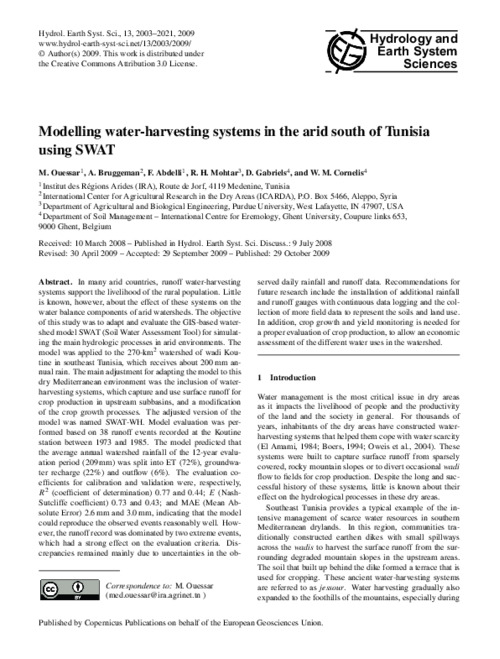Modelling water-harvesting systems in the arid south of Tunisia using SWAT
Abstract
In many arid countries, runoff water-harvesting systems support the livelihood of the rural population. Little is known, however, about the effect of these systems on the water balance components of arid watersheds. The objective of this study was to adapt and evaluate the GIS-based watershed model SWAT (SoilWater Assessment Tool) for simulating the main hydrologic processes in arid environments. The model was applied to the 270-km2 watershed of wadi Koutine in southeast Tunisia, which receives about 200mm annual rain. The main adjustment for adapting the model to this dry Mediterranean environment was the inclusion of waterharvesting systems, which capture and use surface runoff for crop production in upstream subbasins, and a modification of the crop growth processes. The adjusted version of the model was named SWAT-WH. Model evaluation was performed based on 38 runoff events recorded at the Koutine station between 1973 and 1985. The model predicted that the average annual watershed rainfall of the 12-year evaluation period (209 mm) was split into ET (72%), groundwater recharge (22%) and outflow (6%). The evaluation coefficients for calibration and validation were, respectively, R2 (coefficient of determination) 0.77 and 0.44; E (Nash- Sutcliffe coefficient) 0.73 and 0.43; and MAE (Mean Absolute Error) 2.6mm and 3.0 mm, indicating that the model could reproduce the observed events reasonably well. However, the runoff record was dominated by two extreme events, which had a strong effect on the evaluation criteria. Discrepancies remained mainly due to uncertainties in the observed daily rainfall and runoff data. Recommendations for
future research include the installation of additional rainfall and runoff gauges with continuous data logging and the collection of more field data to represent the soils and land use. In addition, crop growth and yield monitoring is needed for a proper evaluation of crop production, to allow an economic assessment of the different water uses in the watershed

